



German Machine Gun Trench with Two Figures, 1917
- Scale / Maßstab: 1/16th (120mm)
- Approx. height of figures: 114 – 115mm
- Material: Resin (figure), Acryl Glass (Plexi – glasses), Plastic Mirrors, Model Plaster (trench parts) / Resin (Figur), Acrylglas (Brille), Kunststoff-Spiegel, Modell-Gips (Grabenteile – synethetische, kunststoffveredelte Gießmasse)
- Parts / Teile: approx / ca. 117 (Note: The Trench Set has only the front section of trench walls / parapets etc. See parts list. Extra plaster wall sections make up the rear wall and left / right of front area. These wall sections, parapets, firing step etc. are not in the webshop, but can be ordered separately if required – just contact Jon Smith direct)
- Infosheet / Infoblatt: English
- Code / Artikel-Nr.: 23MXD
- Attention: Not a toy. Model kit or model making accessories – not suitable for children under 14 years of age. / Achtung: Kein Spielzeug. Modellbauzubehör – nicht für Kinder unter 14 Jahren geeignet
GPSR Data / Angaben
- Manufacturer / Hersteller: Jon Smith Modellbau
- Responsible Person / Verantwortliche Person
- Address: Hannoverstr. 68, 29664 Walsrode, Germany
- Contact / Kontakt: info@jonsmith-modellbau.com
- Tel: +49 (0)5161 8255


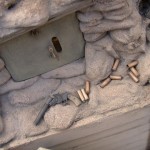

Trench Section in Model Plaster / Graben-Ausschnitt in Modell-Gips:
- 2 x Trench floors with duckboards / 2 Stck. Grabenboden
- Trench Firing Step / Grabenstand
- 3 x Revetment Trench Walls / 3 Stck. Grabenwände
- Sandbag Parapet with Embrasure (MG) / MG-Brüstung
- Sandbag Parapet with Embrasure (for Loophole Plate – 2 parts) / Grabenschild -Brüstung (2 Teile)
- Dugout Entrance with Steps, Landing and Roof Sections (4 parts) / Unterstandeingang, Stufen und Podest (4 Teile)
- Gas Blanket on Shelf / Gasdecke mit Regal
- 8 x Sandbags / 8 Stck. Sandsäcke

Trench Equipment / Graben-Ausrüstung:
- Sniper Shield (5 parts – shield, loophole shutter, shutter handle, carrying hook and support leg) / Grabenschild (5 Teile)
- French Canteen Cup / Französische Tasse



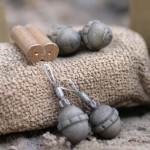
Gas Mask Set M.17
- 3 x Gas Mask M. 17 / 3 Stck. Ledermaske (Gasmaske M.17)
- 3 x Gas Mask Filter / 3 Stck. Filter
- 6 x Eyepieces (Acryl Glass) / 6 Stck. Augengläser
- 3 x Heads (Half, Full and with Field Cap M1910) / 3 Köpfe (halb, voll und mit Feldmütze)
- Canvas Gas Mask Holder / Segeltuchtasche für Gasmaske
- Gas Mask Container M.17 / Gasmasken-Behälter M.17
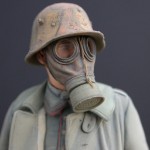

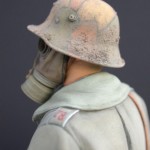

Machine Gun 08/15:
- Machine Gun 08/15 (3 parts) / Maschinengewehr 08/15 (3 Teile)
- Standard MG 08/15 Bipod / MG08/15 Zweibein
- Rubber Steam Hose / Dampfschlauch
- Double-Ended Metal Spare Barrel Container / Ersatzrohr-Behälter
- Drum Magazine (2 parts) / Trommelmagazin oder Patronenkasten 16 (2 Teile)
- Wooden Ammunition Boxes / Munition Holzkisten
- Wooden Ammunition Box – open (3 parts) / Munition Holzkisten – offen (3 Teile)
- Water Container (2 parts) / Wasserbehälter (2 Teile)
- Ammunition Belt / Patronengurt




08/15 MG Gunner:
- Figure (4 parts) / Figur (4 Teile)
- Canvas Gas Mask Holder / Segeltuchtasche für Gasmaske
- Haversack M1887 / Brotbeutel M1887
- Water Bottle M1907 / Feldflasche M1907
- Bayonet 84/98 / Seitengewehr 84/98
- Pistol 08 / Pistole 08
- Stick Grenades M.15 / Stielhandgranaten M.15
- Egg Grenade / Eierhandgranate M.17
- Steel Helmet M.16 with Sandbag Cover / Stahlhelm M.16 mit Sandsack-Überzug
- Signal-Flare Gun (2 parts) Leuchtpistole a. A. alte Art – old type (2 Teile)
- Loose 13mm Flare Gun Ammunition / Lose 13mm Leuchtpistolen-Patronen

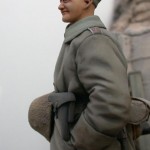
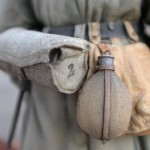

NCO, Western Front 1917:
- Figure (5 parts) / Figur (5 Teile)
- 2 x Spectacles (Acryl Glass) / 2 Stck. Plexi-Brillen
- Mauser C96 Pistol / Mauser C96 Pistole
- Bandolier
- Trench Periscope (4 parts) / Grabenperiscop (4 Teile)
- Stick Grenade M.15 / Stielhandgranate M.15
- Egg Grenades -M.17 / Eierhandgranate M.17
- Steel Helmet M.16 / Stahlhelm M.16
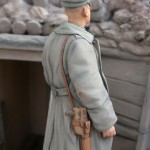



This kit contains all the above and shows just the front section, dugout entrance and steps leading below of a German trench in a front line area. The gunner figure can be placed on the firing step, near the MG position or below on the duckboards.
Below are photos from a completed trench built by myself, utilizing the same model plaster sections (walls / firing steps / duckboards and sandbags) in various stages of assembly.
Stage 1: 


 Stage 1 (Dugout Entrance / Unterstandseingang):
Stage 1 (Dugout Entrance / Unterstandseingang): 


 Stage 1 (Rear of Walls and Dugout / Rückseite von Grabenwände undUnterstand):
Stage 1 (Rear of Walls and Dugout / Rückseite von Grabenwände undUnterstand): 


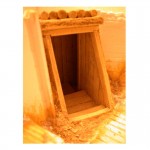 Stage 2:
Stage 2: 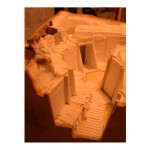


 Stage 3:
Stage 3: 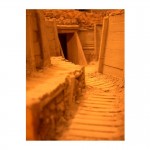
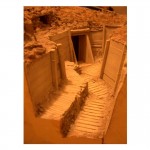

 Stage 3 (Sniper Position / Scharfschützenstand):
Stage 3 (Sniper Position / Scharfschützenstand): 


 Stage 4:
Stage 4: 


 Trench External:
Trench External: 


 Rear Wall (not fixed):
Rear Wall (not fixed): 


 Finished Trench Model:
Finished Trench Model: 


 Finished Trench Model:
Finished Trench Model: 
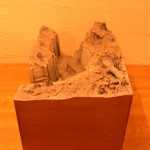

 Construction in the JSM Workshop, Walsrode, Germany 2006 – 7
Construction in the JSM Workshop, Walsrode, Germany 2006 – 7
Extracts from the Infosheet with this kit:
The trench consists of 25 individual pieces cast in high quality modelling plaster or resin and are designed to either fit together as a complete diorama set, or stand separate with their respective figures. The design of the trench, measurements and method of construction has all been reproduced from original photographs and drawings.
The German units would have required the materials locally, in most cases collecting directly from Pioneer supply dumps, behind the front. The parapet pieces would have had more earth on top and in front than could be shown on this model. The rear of the trench has been left out, giving a better view of the figures and accessories. Normally one would see, depending on region, some type of drainage ditch dug at the rear of the trench floor, or under the duckboards.
When constructing the master model, particular care was taken with the choice of materials used. Special attention was paid in reproducing the wood grain on the revetment walls and duckboards; in some cases the wood used was soaked in water for long periods to enable planks to appear warped and bent. Also, general wear and tear with the constant traffic of soldiers has worn some wooden parts down and damaged others. The sandbags have all been modelled giving a distinctive surface texture, with consideration to the folds and creases around the top of the bags near the tying cords.
Wooden Revetment Wall: Set at an angle, slanting outwards from the trench floor and intended to hold back the earthen walls to avoid collapsing (through rain water). The vertical beams are holding the wooden revetment planks in place and these in turn are held by wire attached to pegs and built into the soil underneath the parapet. The top edge to the revetment wall has in places been worn smooth from constant use.
Sandbag Parapet with Embrasure (Mg): The parapet (para pâte, ‘protect head’) has been built up using sandbags. The parados (para dos, ‘protect back’) or rear wall of trench would have been built higher. The embrasure is for interlocking indirect fire (enfilade defence), covering a designated area between and within the trench systems. The first sandbag layers of the parapet have been flattened by the weight of the ones above and appear thinner. Some of the bags show the prominent seems at the sides and underneath; others are damaged, with the contents spilling out. A thick log and further sandbags on top have reinforced the embrasure lintel. A few tie cords around tops of sandbags are visible, but more could be added separately as these would in some cases hang freely.
Sandbag Parapet With Embrasure & Loophole Plate: Built into the right hand sandbag parapet is the so-called sniper shield. This should slide into place from the top adding the sandbag lintel afterwards.
Steel Trench Shield M16 / Infanterieschutzschild M16: Designed originally as a portable piece of armour for securing positions and seen mostly built into trench defences, particularly during the first years of the war. A rotating loophole cover could be operated from the inside, with a weld-rivet on the outside of the shield to hold it in the open position. A carrying hook and support arm are also attached to the rear of the shield. The offset loophole enabled a right-handed person to fire through the opening with the head protected. Produced in large numbers before and at the start of the conflict, but later discontinued due to shortage of raw materials. The loophole would have been carefully camouflaged from the front. The support arm was sometimes removed, or pushed to one side when the shield was built into a position. The distance from the rear of shield to the top of trench wall would have been measured out, giving a comfortable position for the soldier to rest the elbows and aim his rifle. Colour: grey.
Tip: the shield is a thin item and to avoid light shining through the resin one can undercoat with several layers of metallic paint.
Firing Step: The built-up fire step is constructed from a sandbag outer wall, log platform and filled with earth. A slight incline to the rear is to enable any rainwater to drain off the surface. On the left side, a sandbag has collapsed causing part of the log platform to fall in – this can be drilled out further under the supporting log.
Trench Floor with Duckboards: This depicts a section of trench floor; complete with slatted wooden duckboards. The end wooden slats on one of the boards have bowed downwards with the constant use. Underneath the duckboard was normally the trench sump or drainage. The floor is generally muddy and a few footprints can be made out here and there. The gunner figure has 2 alternative positions; either standing on the firing step, or on the duckboards. Colour: if untreated, wood when outside for longer periods will turn grey.
Dugout Entrance / Steps: A dugout entrance has been built into the parapet wall. The entrance has a sloping timber frame with a raised first step or threshold to avoid rainwater running down into the dugout. The space above the entrance and below the layer of log roofing is to mount the gas blanket and shelf. The manner of timber construction (using mortice and tenon joints) are standard German engineering methods of the time, along with height of steps (the standard height of the step is around 17-18 cm – any large variation to this measurement and it becomes unnatural for people to walk up and down steps). The upper surfaces, particularly the middle landing has been worn down from the constant traffic of hob-nailed boots. Mud/dirt has collected in the corners and outside edges.
Note: the dugout section will have to be let into the baseboard on the trench diorama – the bottom edges of the entrance frame equal the under surface of the duckboards.
Gas blanket and shelf: Designed to be quickly rolled down in the event of a gas attack. The sides of the blanket (or similar material i.e. poncho) should overlap the sides of the dugout entrance frame and were sometimes weighted at the bottom with an iron rod or timber, to allow for a tighter fit. A second gas blanket would normally be installed at the bottom of the dugout stairs.
Individual Sandbags: Some of the bags have been modelled to lean up against trench walls; others can be built into the earth parapet. One of the bags is damaged with the contents spilling out on one side.
 An deutschsprachige Interessenten:
Sie können mich per eMail oder Telefon auch gerne auf deutsch kontaktieren. Ortsbesuch ist nach Absprache möglich.
An deutschsprachige Interessenten:
Sie können mich per eMail oder Telefon auch gerne auf deutsch kontaktieren. Ortsbesuch ist nach Absprache möglich.
